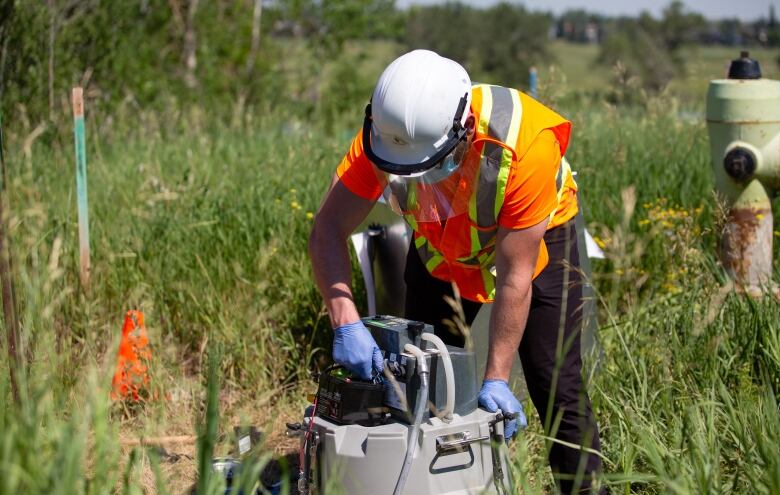[ad_1]
Alberta may be seeing the early signs of a predicted fall COVID-19 upswing, but experts say it’s too early to say just how bad it will get.
The number of people hospitalized with COVID jumped to 843 for the week ending on Sept. 20, from 819 the previous week. There was a similar bump the week before.
Intensive care unit admissions related to the virus have remained steady at 26 last week.
“We’re starting to see more and more COVID cases coming into the [emergency room],” said Dr. Paul Parks, section president for emergency medicine with the Alberta Medical Association.
“I absolutely think it’s the beginning of another surge. It’s hard to tell how big it’s going to peak or how bad it’s going to hit us because we’ve pretty much abandoned any sort of meaningful surveillance.”
The trouble is, Alberta’s hospitals are in the midst of a severe staffing shortage. Emergency room beds are full of patients waiting for beds on the wards, ER waits can be extremely long, patient diversions are increasingly common, and staff are scrambling to provide timely care.
“To be blunt, our system’s in disaster mode everyday … our capacity is strained as bad as it’s been for a long, long time, starting at the start of fall and going into winter, and that’s got us all very, very worried.”
Positivity rate uptick
Alberta’s positivity rates, which have remained stubbornly high this year with the elimination of public health measures, are ticking up, too.

The seven-day average increased from 16.94 per cent to 19.52 per cent in the latest update.
“There has been a recent uptick in the per cent positivity. And that, in the past, has usually been one of the earlier signs that the numbers might start going up again,” said Dr. Lynora Saxinger, infectious diseases specialist at the University of Alberta.
“I think that we could be at the beginning of some kind of surge, and I think there is likely to be a surge. But we don’t know really how severe it will be.”
These early indicators come with a backdrop of fairly high community transmission over the summer, according to Saxinger.
“We’ve had probably 20-30 hospital admissions per day for much of the summer, probably around three deaths per day for much of the summer. So COVID never really went away.”
And while COVID-related hospital pressures were not as bad over the summer as they have been previously, it’s unclear just how the fall surge could play out, she said.
Vaccination rates, previous infections and waning immunity also make it hard to predict.
“It’s just going to be a really uncertain time, and caution is definitely warranted.”

Smaller waves
With children back in school, holidays such as Thanksgiving approaching, and cooler weather forcing people indoors, transmission will grow, according to Dr. Dan Gregson, an infectious disease physician and medical microbiologist with the University of Calgary’s Cumming School of Medicine.
But Alberta’s COVID-19 waves are getting progressively smaller, he noted.
“We’re expecting a peak. Assuming nothing drastic happens, I would say that peak is not going to be as high as what we’ve seen in the past,” said Gregson.
“It will result in more admissions to hospital. But our ICUs aren’t anywhere near what they were last year at this time.… Things are better this year.”
There are several wild cards, though. While unlikely, he said, a new, tougher variant could take hold, resulting in more transmission and hospitalization.
And with a difficult flu season predicted, hospitals are expecting a surge in those cases, too.

Watching wastewater
Alberta’s wastewater surveillance team is keeping a close eye on global trends so that it can start testing for new variants quickly once they arrive in Canada.
“There’s lots of things that are potentially poised to become a problem. And it probably requires the right circumstance in the environment that it’s circulating,” said Dr. Michael Parkins, an infectious disease specialist with the University of Calgary and one of the program leaders.
“Whether they come to fruition or not, only time will tell.”
Travel is one of those factors, he said.
According to Parkins, it’s too early to draw any conclusions about a fall surge from the current wastewater data.
“We’re seeing things bounce around a little but no clear trend towards the increase. [And] no clear trends towards further reductions,” he said, noting some regions such as Banff have shown modest increases recently while others are relatively flat.
“Even now, in a period of low-ish SARS CoV-2 activity, it’s much higher than it’s been even at the worst parts of the earlier pandemic. So people do need to remain vigilant.”
Meanwhile, doctors are urging Albertans to get whatever dose of the COVID-19 vaccine they’re eligible for, including the new bivalent booster shots that recently became available.
“I think booster planning will actually potentially really be helpful in terms of the amount of illness we see in the community because the new booster should be more effective against transmission and infection,” Saxinger said.
[ad_2]
Source link




